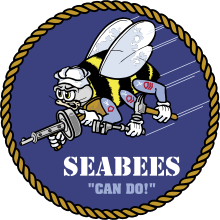Seabees
| Seabees | |
|---|---|

The Seabee logo
|
|
| Active | 5 March 1942 – present |
| Country |
|
| Branch |
|
| Role | Militarized construction |
| Size |
|
| Motto(s) |
|
A Seabee is a member of the United States Naval Construction Forces (NCF). The word "Seabee" is a heterograph of the first initials of the words "Construction Battalion" i.e. C.B. = Seabee. The Seabees legacy comes from the construction of hundreds of miles of airstrips and roadways, the dredging of harbors and building of piers, while building anything and everything it took to accomplish the mission in whatever theater they were assigned going back to 1942. As combat engineers, they build and demolish to support the rest of the forces.
In December 1941, with U.S. involvement in war soon expected on both the Pacific and Atlantic Oceans, Rear Admiral Ben Moreell, Chief of the Navy's Bureau of Yards and Docks, recommended establishing Naval Construction Battalions at Davisville Naval Construction Battalion Center at Davisville, Rhode Island. With the attack on Pearl Harbor and the United States' entry into the war, he was given the go-ahead. The Davisville Advanced Base Depot became operational in June 1942. It eventually contained 500 Quonset huts for personnel. On August 11, 1942, the Naval Construction Training Center, known as Camp Endicott, was commissioned at Davisville. The Camp trained over 100,000 Seabees during World War II. Camp Thomas, a personnel-receiving station on the base, was established in October of that year.
In California in May 1942, a base for supporting the Naval Construction Force was established at Port Hueneme in Ventura County, California. This base became responsible for shipping large amounts of equipment and matériel to the efforts in the Pacific.
The earliest Seabees were recruited from the civilian construction trades and were placed under the leadership of the Navy's Civil Engineer Corps. Because of the emphasis on experience and skill rather than physical standards, the average age of Seabees during World War II was 37.
...
Wikipedia
